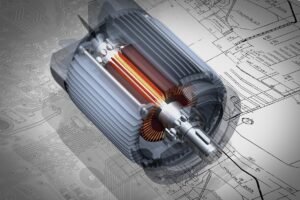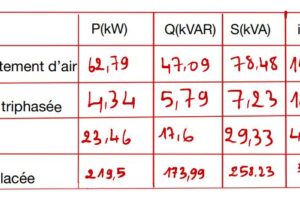
The electrical power balance according to NF 15-100
- Posted by lokmane boussaa
- Categories Bilan de puissance électrique, Conception installation électrique basse tension, Electricité Basse tension
- Date 23 janvier 2022
- Comments 0 comment
- Tags active power, apparente power, bilan des puissances, Coincidence factor, demand factor, Diversity factor, electrical power balance, expansion factor, facteur de foisonnement, facteur de simultaniété, Factor of maximum utilization, ks, ku, power factor, reactive power, utilisation factor
Why do we need to do an electrical power balance?
The electrical power balance is essential for:
- define the power of the source (transformer, generator, inverters, etc.)
- calculation of cable sections.
- choice of electrical protection ratings.
- calculation of UPS autonomy.
- others.
Three-phase alternating powers AC
For any AC system we define three powers:
APPARENT POWER : S S = U.I.√3 S expressed in VA
ACTIVE POWER : P P=U.I.√3 cosφ P expressed in W
REACTIVE POWER: Q Q=U.I.√3 sinφ Q expressed in VAR
U being the phase-to-phase voltage
Single-phase alternating powers AC
APPARENT POWER : S S = V.I S expressed in VA
ACTIVE POWER : P P=V.I. cosφ P expressed in W
REACTIVE POWER: Q Q=V.I. sinφ Q expressed in VAR
V being the simple tension
The Power Triangle
If we apply the Pythagorean Theorem, we can determine:
cosφ= P / S (Called Power Factor)
sinφ= Q / S
S=√((P^2 +Q^2)

DC Direct Current powers
APPARENT POWER : S S = U.I S expressed in VA
ACTIVE POWER: P P=U.I. P expressed in W
REACTIVE POWER: Q Q=0 Q expressed in VAR
Maximum load current: IB
It should be remembered that in reality all the individual loads do not necessarily operate at full nominal power nor necessarily at the same time.
To be able to estimate the maximum current the standard has defined three factors,
- Factor of maximum utilization (ku).
- Diversity factor – Coincidence factor (ks).
- expansion factor (kext).
IB=In*Ku*Ks*kext
Supercharge Your Calculations
Experience lightning-fast calculations with Calcelect 2023.
LOKELECT ENGINEERING presents its latest innovation in electrical technology: an Electrical Power Balance Calculation Software, designed to simplify and optimize electrical engineering projects within the Windows environment.
CALC-ELECT - 1 mois
- Subscription duration: 1 month
- Benefit from updates during the subscription period
Prix: €12.00
CALC-ELECT - 3 mois
- Subscription duration: 3 month
- Benefit from updates during the subscription period
Prix: €34.00
CALC-ELECT - 6 mois
- Subscription duration: 6 month
- Benefit from updates during the subscription period
Prix: €65.00
Collection of information
The designer of the electrical installation must collect information from the documents sent by his client or from the specifications, in order to complete the table above, as well as:
- determination of the characteristics of each circuit.
- Operating conditions. (coefficient of use, simultaneity, external influences, etc.).
- Continuity of service.
Factor of maximum utilization (ku)
In normal operation the consumption of the equipment is sometimes less than the nominal consumption indicated on the nameplate.
This justifies the use of a factor called Factor of maximum utilization (ku) to estimate the maximum electrical consumption
| Type of load | Ku |
| Lighting or heating | 1 |
| Power sockets (unless otherwise indicated) | 1 |
| Electric motors | 0.75 |
Diversity factor - Coincidence factor (ks).
The determination of ks factors is the responsibility of the designer, since it requires a detailed knowledge of the installation and the conditions in which the individual circuits are to be exploited. For this reason, it is not possible to give precise values for general application.
Diversity factor for an apartment block
Example of diversity factors for an apartment block as defined in French standard NFC14-100, and applicable for apartments without electrical heating
| Number of downstream consumers | Diversity factor (ks) |
| 2 to 4 | 1 |
| 5 to 9 | 0.78 |
| 10 to 14 | 0.63 |
| 15 to 19 | 0.53 |
| 20 to 24 | 0.49 |
| 25 to 29 | 0.46 |
| 30 to 34 | 0.44 |
| 35 to 39 | 0.42 |
| 40 to 49 | 0.41 |
| 50 and more | 0.38 |
Rated Diversity Factor for distribution switchboards
Rated diversity factor for distribution boards (cf IEC61439-2 table 101)
| Type of load | Assumed loading factor |
| Distribution - 2 and 3 circuits | 0.9 |
| Distribution - 4 and 5 circuits | 0.8 |
| Distribution - 6 and 9 circuits | 0.7 |
| Distribution - 10 or more circuits | 0.6 |
| Electric actuator | 0.2 |
| Motors ≤ 100 kW | 0.8 |
| Motors > 100 kW | 1 |
Diversity factor according to circuit function
Diversity factor according to circuit function (see UTE C 15-105 table AC)
| Circuit function | Diversity factor (ks) |
| Lighting | 1 |
| DHeating and air conditioning | 1 |
| Socket-outlets | 0.1 to 0.2 |
| For the most powerful motor | 1 |
| For the second most powerful motor | 0.75 |
| For all motors | 0.6 |
In certain cases for socket outlets, notably in industrial installations, this factor can be higher.
and there is another way to calculate this factor : Ks = (0,1 + 0,9/N)
where N is the number of outlets
Expansion factor (kext).
The role of the reserve factor, also called expansion factor, is to predict an increase in the absorbed power.
The coefficient varies from 1.15 to 1.25, we generally take Kext = 1.25
to read more a topic I recommend the following page
CALC-ELECT - Évaluation 5 jours
- Benefit from updates during the subscription period
Prix: €0.00
CALC-ELECT - Évaluation 5 jours
- Benefit from updates during the subscription period
Prix: €0.00
Consultant Formateur Electricité Basse tension
Ingénieur en électrotechnique de formation ayant une solide expérience dans le domaine de la distribution électrique Basse tension ainsi que la qualités de l’énergie Electrique.
Créateur du SITE LOKELECT ENGINEERING
You may also like

Le démarrage direct des Moteurs Asynchrones

Exercice corrigé de bilan des puissances

